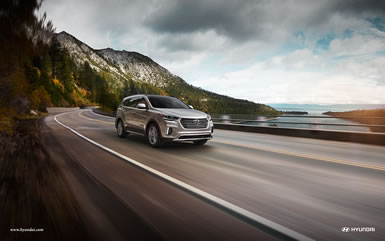|
|

The 2017 Hyundai Santa Fe Sport Review: Crossover SUVs are the growth area of the auto business, and Hyundai wants its share of the action. The 2017 Santa Fe and Santa Fe Sport are right in the heart of it. The word “Sport” isn’t about providing a more exhilarating driving experience, it’s about size and function. While the Santa Fe offers three-row seating and V6 power, the Sport is a shorter, lighter two-row crossover with room for five, powered by a four-cylinder engine.
Choose from the L, T, and T Ultimate models. The L gets you a 2.4-liter four with 185 horsepower and 178 lb.-ft. of torque, while the T’s enliven the equation with a 2.0-liter turbocharged four that kicks out 240 horsepower and 260 lb.-ft. of torque. All Santa Fe Sports come with a six-speed automatic transmission, and you can order all-wheel drive in any model.
All-wheel drive used to be a main attraction of truck-based SUVs, when driving off-road was a real possibility. Now, it’s mostly a safety enhancement for inclement weather. Adding traction to the rear wheels now will cost you $1,750 and 1-2 miles per gallon in fuel efficiency.
Speaking of that topic, the Santa Fe Sport front-wheel-drive 2.0T Ultimate, like my test car, gets EPA fuel economy numbers of 20 City, 27 Highway, 23 Combined. I averaged 22.4 mpg, not bad for a vehicle that weighs 3,949 lbs. The Green numbers are 6 for Smog and 5 for Greenhouse Gas, that’s average. The fuel economy numbers for 2017 models are about 1 mpg better than the 2016 models.
Hyundai is proud of the updates for the 2017s. While relatively minor after a major update last year, the front end gets a new grille with a brushed metal look. The tail end is updated too, with LED taillamps. The alloy wheels, which come in 17, 18, and 19-inch sizes, are new this year. My tester, in a new shade of Nightfall Blue, came with stylish 19-inchers.
Hyundai is evolving its product design from the flamboyant Fluidic Sculpture motif to the more restrained Dynamic Precision language. The Santa Fe still wears much of the former in its body panels but the grille is more of the latter. The side windows run along smoothly until the middle of the rear doors, when they head dramatically upward, culminating in a sharp point in the rear quarter. It’s a little like the old American Motors Gremlin, although no-one at Hyundai was likely referencing that product.
The Fluidic Sculpture look is evident inside, and makes for a flowing, attractive environment. Hyundai has worked hard to give their products character and make sure materials look and feel substantial, so it’s a happy experience to sit behind the wheel. The 8-inch color touchscreen is one of easiest to use in the industry, and for 2017 you can have it with integrated Android Audio, which should please about half of the cellular phone users.
Like most cars, the Santa Fe Sport comes in a well-equipped regular model, with things like keyless entry, Bluetooth connectivity, and steering-wheel-mounted audio and cruise control. But they also offer you a couple of steps up. My 2.0T Ultimate had front-wheel drive, so it was one step below the true top dog, which has all-wheel drive.
But, ultimate isn’t just a buzzword here. For the extra cash, you get heated and ventilated leather-covered seating, the Infinity premium audio system with QuantumLogic Surround sound, dual automatic temperature control, an enormous panoramic sunroof, and lots more.
There’s even the Hands-Free Smart Liftgate. While Ford is excited about its version where you wave one foot under the tailgate, with Hyundai’s, you just walk up and stand near the liftgate for a few seconds and it opens! Handy when you’ve got an armload of groceries, for sure.
My tester added to the excitement with the Ultimate Tech Package for $1,550. It brought in Smart Cruise Control, a better way to automatically keep a safe distance from the car ahead. It also features Automatic Emergency Braking with Pedestrian Detection for safety. There’s Lane Departure Warning and the Dynamic Bending Light technology for “seeing around corners.” Plus the high beams go on and off automatically and are auto leveling.
Grab the 2.4L with front wheel drive and you’re looking at $26,245, including shipping. My 2.0T Ultimate came in at $39,070. By Steve Schaefer © AutoWire.Net
The 2017 Hyundai Santa Fe Sport Bottom Line Review provided by:
Tony Leopardo © AutoWire.Net
The Bottom Line: The 2017 Hyundai Santa Fe Sport’s popularity led to it joining the assembly line at Hyundai’s West Point, Georgia assembly plant this year. It contains half Korean and half U.S. parts, making it a certain kind of hybrid. Once upon a time, Hyundai made cheap little cars that weren’t that great, but were terrific values. Now, they are fully competitive, with top quality ratings and industry-leading design. With continuous improvement, Hyundai is now a brand is worth getting excited about. And maybe, just for those reasons alone, you should “Drive one, Buy one, Today ©”. Bottom Line Review provided by: Tony Leopardo © AutoWire.Net
“Tony the Car Guy” is an automotive writer, editor and publisher in the San Francisco Bay Area. If you have a question or comment for Tony send it to TonyLeo@pacbell.net or visit AutoWire.Net at www.autowire.net - And remember: “You Are What You Drive ©”

Hyundai Homepage
Column Name: Crossover SUVs are the growth area of the auto business
Topic: The 2017 Hyundai Santa Fe Sport
Word Count: 955
Photo Caption: The 2017 Hyundai Santa Fe Sport
Photo Credits: Hyundai Internet Media
Series #: 2016- 25
Download
the Microsoft Word version here:
2017 Hyundai Santa Fe Sport
Download the Original Image File here:
2017 Hyundai Santa Fe Sport


|
